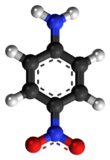Chemistry:4-Nitroaniline
|
| |||

| |||
| Names | |||
|---|---|---|---|
| Preferred IUPAC name
4-Nitroaniline | |||
| Systematic IUPAC name
4-Nitrobenzenamine | |||
| Other names
p-Nitroaniline
1-Amino-4-nitrobenzene p-Nitrophenylamine | |||
| Identifiers | |||
3D model (JSmol)
|
|||
| 508690 | |||
| ChEBI | |||
| ChEMBL | |||
| ChemSpider | |||
| EC Number |
| ||
| 27331 | |||
| KEGG | |||
PubChem CID
|
|||
| RTECS number |
| ||
| UNII | |||
| UN number | 1661 | ||
| |||
| |||
| Properties | |||
| C6H6N2O2 | |||
| Molar mass | 138.12 g/mol | ||
| Appearance | yellow or brown powder | ||
| Odor | faint, ammonia-like | ||
| Density | 1.437 g/ml, solid | ||
| Melting point | 146 to 149 °C (295 to 300 °F; 419 to 422 K) (lit.) | ||
| Boiling point | 332 °C (630 °F; 605 K) | ||
| 0.8 mg/ml at 18.5 °C (IPCS) | |||
| Vapor pressure | 0.00002 mmHg (20°C)[1] | ||
| -66.43·10−6 cm3/mol | |||
| Hazards | |||
| Main hazards | Toxic | ||
| Safety data sheet | JT Baker | ||
| GHS pictograms |  
| ||
| GHS Signal word | Warning | ||
| H301, H311, H331, H373, H412 | |||
| P260, P261, P264, P270, P271, P273, P280, P301+310, P302+352, P304+340, P311, P312, P314, P321, P322, P330, P361, P363, P403+233, P405, P501 | |||
| NFPA 704 (fire diamond) | |||
| Flash point | 199 °C (390 °F; 472 K) | ||
| Lethal dose or concentration (LD, LC): | |||
LD50 (median dose)
|
3249 mg/kg (rat, oral) 750 mg/kg (rat, oral) 450 mg/kg (guinea pig, oral) 810 mg/kg (mouse, oral)[2] | ||
| NIOSH (US health exposure limits): | |||
PEL (Permissible)
|
TWA 6 mg/m3 (1 ppm) [skin][1] | ||
REL (Recommended)
|
TWA 3 mg/m3 [skin][1] | ||
IDLH (Immediate danger)
|
300 mg/m3[1] | ||
| Related compounds | |||
Related compounds
|
2-Nitroaniline, 3-Nitroaniline | ||
Except where otherwise noted, data are given for materials in their standard state (at 25 °C [77 °F], 100 kPa). | |||
| Infobox references | |||
4-Nitroaniline, p-nitroaniline or 1-amino-4-nitrobenzene is an organic compound with the formula C6H6N2O2. A yellow solid, it is one of three isomers of nitroaniline. It is an intermediate in the production of dyes, antioxidants, pharmaceuticals, gasoline, gum inhibitors, poultry medicines, and as a corrosion inhibitor.[3]
Synthesis
4-Nitroaniline is produced industrially via the amination of 4-nitrochlorobenzene:[3]
- ClC6H4NO2 + 2 NH3 → H2NC6H4NO2 + NH4Cl
Below is a laboratory synthesis of 4-nitroaniline from aniline. The key step in this reaction sequence is an electrophilic aromatic substitution to install the nitro group para to the amino group. The amino group can be easily protonated and become a meta director. Therefore, a protection of the acetyl group is required. After this reaction, a separation must be performed to remove 2-nitroaniline, which is also formed in a small amount during the reaction.[4]

Applications
4-Nitroaniline is mainly consumed industrially as a precursor to p-phenylenediamine, an important dye component. The reduction is effected using iron metal and by catalytic hydrogenation.[3]
It is a starting material for the synthesis of Para Red, the first azo dye:[5]
Laboratory use
Nitroaniline undergoes diazotization, which allows access to 1,4-dinitrobenzene[6] and nitrophenylarsonic acid.[7] With phosgene, it converts to 4-nitrophenylisocyanate.[8] [9]
Carbon snake demonstration
When heated with sulfuric acid, it dehydrates and polymerizes explosively into a rigid foam.[10]
In Carbon snake demo, paranitroaniline can be used instead of sugar, if the experiment is allowed to proceed under an obligatory fumehood.[11] With this method the reaction phase prior to the black snake's appearance is longer, but once complete, the black snake itself rises from the container very rapidly.[12] This reaction may cause an explosion if too much sulfuric acid is used.[13]
Toxicity
The compound is toxic by way of inhalation, ingestion, and absorption, and should be handled with care. Its -1">50 in rats is 750.0 mg/kg when administered orally. 4-Nitroaniline is particularly harmful to all aquatic organisms, and can cause long-term damage to the environment if released as a pollutant.[14]
See also
References
- ↑ 1.0 1.1 1.2 1.3 NIOSH Pocket Guide to Chemical Hazards. "#0449". National Institute for Occupational Safety and Health (NIOSH). https://www.cdc.gov/niosh/npg/npgd0449.html.
- ↑ "p-Nitroaniline". Immediately Dangerous to Life and Health Concentrations (IDLH). National Institute for Occupational Safety and Health (NIOSH). https://www.cdc.gov/niosh/idlh/100016.html.
- ↑ 3.0 3.1 3.2 Booth, Gerald (2003-03-11). "Nitro Compounds, Aromatic". in Wiley-VCH (in en). Ullmann's Encyclopedia of Industrial Chemistry (1 ed.). Wiley. doi:10.1002/14356007.a17_411. ISBN 978-3-527-30385-4. https://onlinelibrary.wiley.com/doi/abs/10.1002/14356007.a17_411.]
- ↑ Mohrig, J.R.; Morrill, T.C.; Hammond, C.N.; Neckers, D.C. (1997). "Synthesis 5: Synthesis of the Dye Para Red from Aniline". Experimental Organic Chemistry. New York, NY: Freeman. pp. 456–467. http://web.centre.edu/muzyka/organic/lab/paraRed05.htm. Retrieved 2007-07-18.
- ↑ Williamson, Kenneth L. (2002). Macroscale and Microscale Organic Experiments, Fourth Edition. Houghton-Mifflin. ISBN 0-618-19702-8. https://archive.org/details/macroscalemicros00will_0.
- ↑ Starkey, E. B. (1939). "p-DINITROBENZENE". Organic Syntheses 19: 40. doi:10.15227/orgsyn.019.0040. http://orgsyn.org/demo.aspx?prep=CV2P0225.
- ↑ "p-NITROPHENYLARSONIC ACID". Organic Syntheses 26: 60. 1946. doi:10.15227/orgsyn.026.0060. http://orgsyn.org/demo.aspx?prep=CV3P0665.
- ↑ Shriner, R. L.; Horne, W. H.; Cox, R. F. B. (1934). "p-NITROPHENYL ISOCYANATE". Organic Syntheses 14: 72. doi:10.15227/orgsyn.014.0072. http://orgsyn.org/demo.aspx?prep=CV2P0453.
- ↑ "2,6-DIIODO-p-NITROANILINE". Organic Syntheses 12: 28. 1932. doi:10.15227/orgsyn.012.0028. http://orgsyn.org/demo.aspx?prep=CV2P0196.
- ↑ Poshkus, A. C.; Parker, J. A. (1970). "Studies on nitroaniline–sulfuric acid compositions: Aphrogenic pyrostats". Journal of Applied Polymer Science 14 (8): 2049–2064. doi:10.1002/app.1970.070140813. https://onlinelibrary.wiley.com/doi/10.1002/app.1970.070140813.
- ↑ Summerlin, Lee R.; Ealy, James L. (1988). "Experiment 100: Dehydration of p-Nitroaniline: Sanke and Puff". Chemical Demonstrations: A Sourcebook for Teachers Volume 1 (2nd ed.). American Chemical Society. pp. 171. ISBN 978-0-841-21481-1. https://eric.ed.gov/?id=ED286722.
- ↑ "Carbon Snake: demonstrating the dehydration power of concentrated sulfuric acid" (in en). 2013-06-06. https://communities.acs.org/t5/Educators-and-Students/Carbon-Snake-demonstrating-the-dehydration-power-of-concentrated/td-p/7732.
- ↑ (in en) Making a carbon snake with P-Nitroaniline, https://www.youtube.com/watch?v=YKHUnHDphTc, retrieved 2022-01-31
- ↑ "4-Nitroaniline". St. Louis, Missouri: Sigma-Aldrich. December 18, 2020. https://www.sigmaaldrich.com/SG/en/sds/aldrich/185310.
External links
- Safety (MSDS)data for p-nitroaniline
- MSDS Sheet for p-nitroaniline
- Sigma-Aldrich Catalog data
- CDC - NIOSH Pocket Guide to Chemical Hazards
 |





